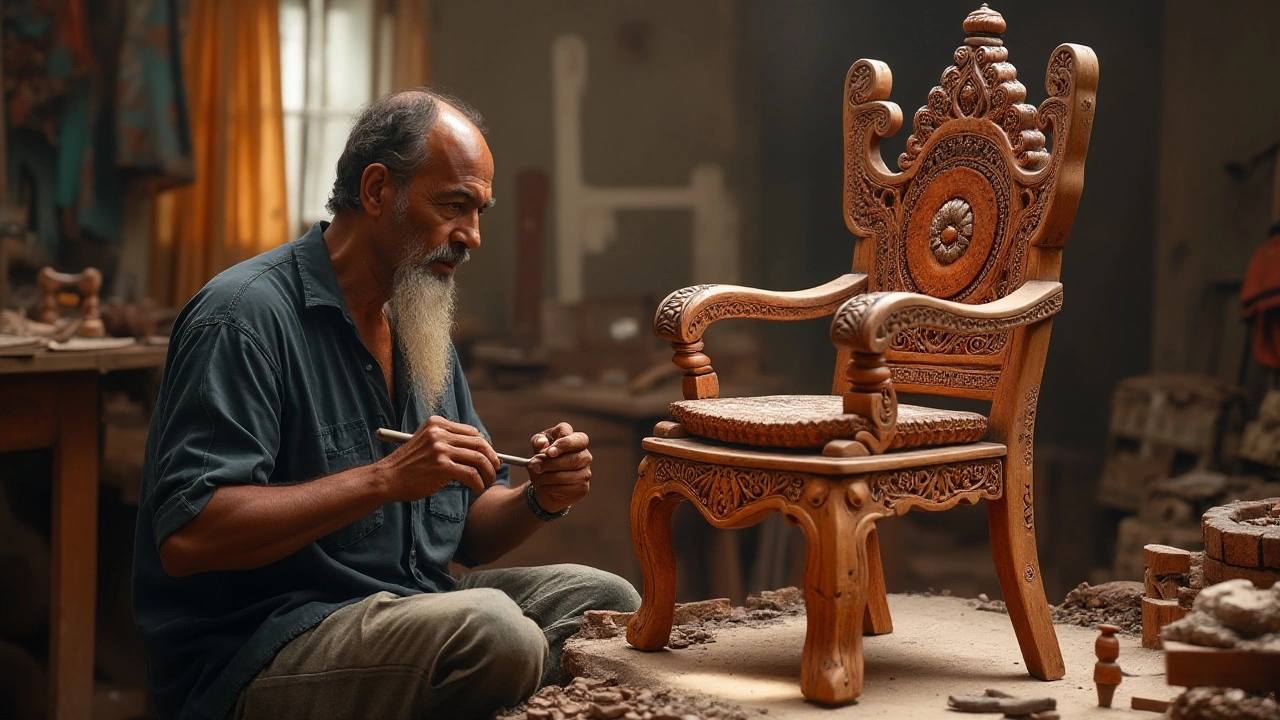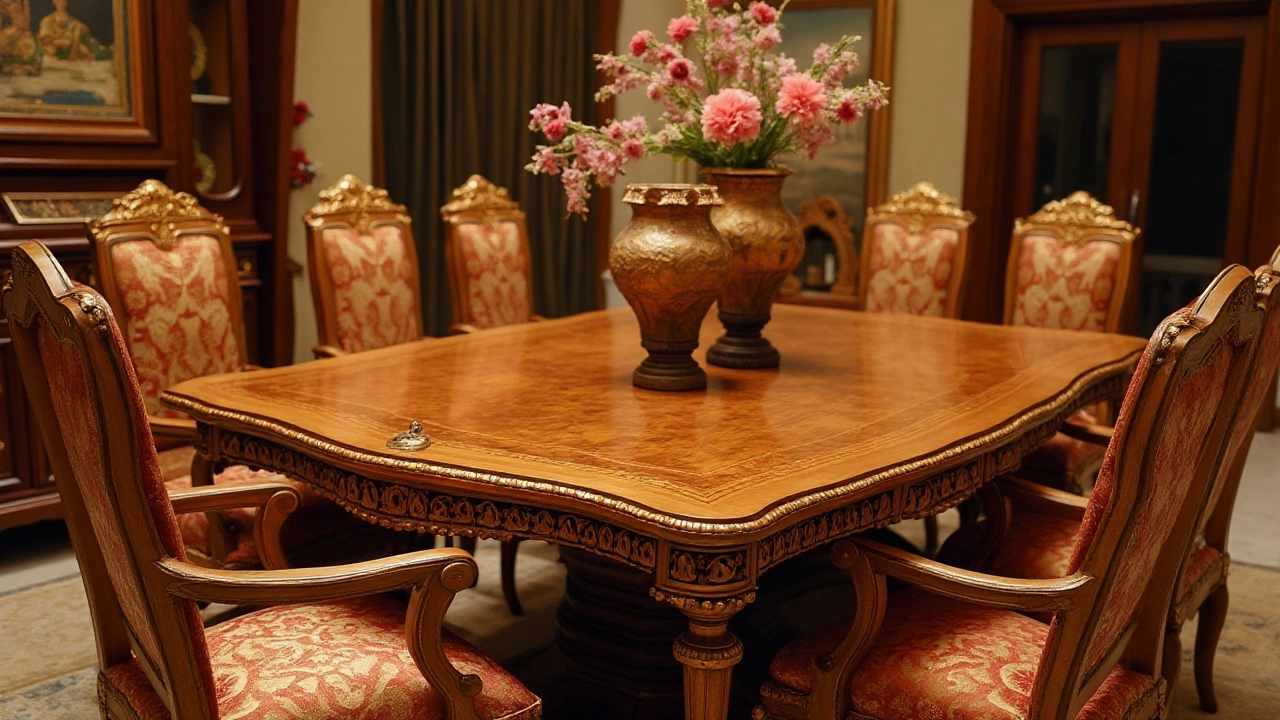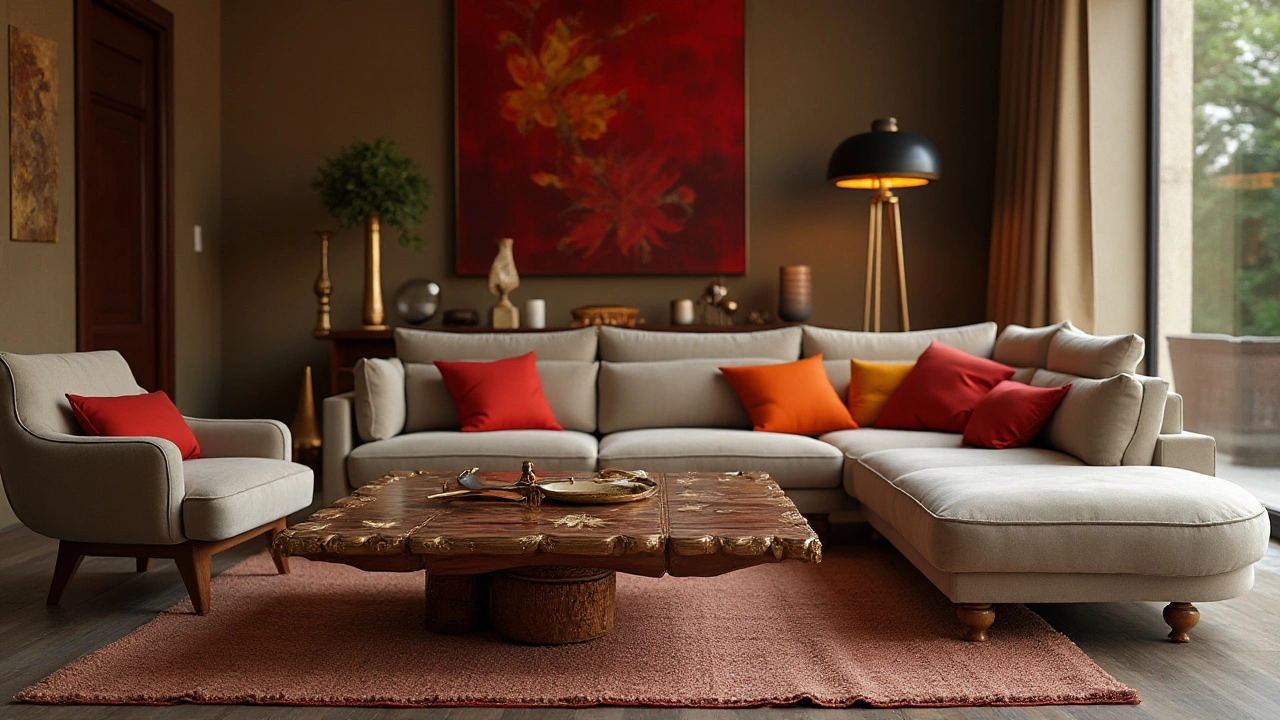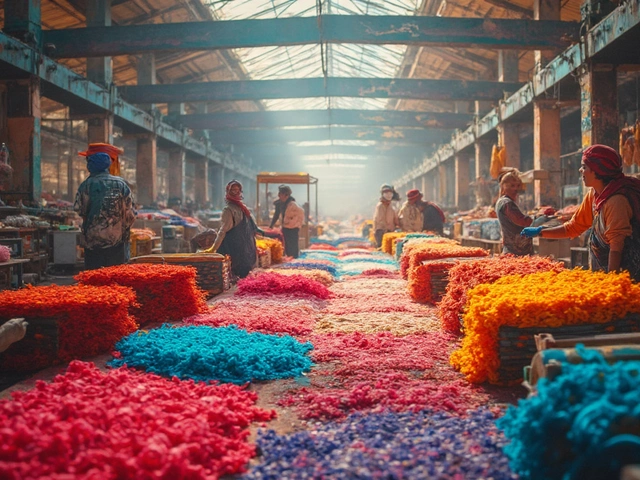When one thinks of fine furniture, India may not immediately spring to mind, but it should. The country is a treasure trove of artistry and tradition, especially within the realm of furniture making. High-end brands across India meticulously blend the rich history of craftsmanship with modern luxury, creating pieces that are as much artwork as they are functional.
In this exploration, we delve into the world of India's most renowned furniture makers. They are transforming spaces with their unique creations, using both local materials and international design inspiration. Whether you’re furnishing a palace or a cozy nook, these artisans have something remarkable to offer.
- Indian Craftsmanship and Its Legacy
- Top Luxury Furniture Brands in India
- Unique Styles and Signature Designs
- Sourcing and Materials Used
- Adapting Tradition to Modern Needs
- Tips for Choosing High-End Furniture
Indian Craftsmanship and Its Legacy
Indian craftsmanship extends far beyond what meets the eye. This rich tradition has roots deeply embedded in the country's historical and cultural milieu. Furniture making in India is an ancient art, with its origins tracing back to the times when royals graced their palaces with ornately carved woodwork. This legacy continues to influence the high-end furniture crafted today, providing a taste of opulence akin to that of bygone eras. The skillset has been passed down through generations, often remaining within families who have dedicated their lives to mastering this craft. Among the materials used, wood remains the prime choice, with teak and rosewood standing out for their durability and lush appearance. Artisans imbue these raw materials with life, transforming them into stunning decor that either echo ancient architectural motifs or explore contemporary design themes.
India's handcrafted furniture is renowned not only for its aesthetics but also for the stories embedded within each creation. It's about celebrating the art of creation. Each piece acts as a canvas reflecting the diverse cultural landscapes across India, from the intricate inlays of Rajasthan to the minimalist lines favored in urban studios. The influence of local cultures is evident in every curve and motif. An oft-repeated phrase by connoisseurs is 'art inside wood,' exemplifying how traditional craftsmanship continues to evolve yet stays rooted in its origins. As Kapila Vatsyayan, a noted scholar on Indian arts, once reflected, "Indian art and craftsmanship express the rhythm of life. It celebrates tangibility through textures and forms."
“The richness of Indian craftsmanship lies not just in the hands that shape it, but in the soul that breathes into it.”
The appeal of luxury furniture India offers to the world is undeniable. The blend of traditional techniques with modern design aesthetics creates pieces that are unique and timeless. Collectors and enthusiasts often seek such creations for their intricate beauty and the quality guaranteed by the laborious, skilled processes involved. There's a growing appreciation for furniture that tells a story, a trend visible in high-end markets globally. Dining tables, cabinets, and chairs are no longer mere functional pieces; they are cultural symbols and art forms that embody India's diverse artisanal heritage. As interest in sustainability grows, these handmade pieces also appeal to environmentally-conscious buyers intrigued by the favorable environmental impact brought by the use of traditional methods and sustainable resources.
Top Luxury Furniture Brands in India
India's love affair with luxury furniture is deeply rooted in its rich tapestry of culture and heritage. This legacy has spawned a number of distinguished brands that have not only captured the essence of traditional Indian design but have also woven contemporary elements into their creations. Among these brands, luxury furniture India makers are acclaimed for their outstanding ability to design pieces that do more than just fill a space; they tell a story.
One notable name in this sphere is Godrej Interio, a brand that successfully marries innovation with functionality. They are recognized for their extensive research into materials, environmental practices, and cutting-edge technology, which helps them create iconic furniture that appeals to modern sensibilities while keeping utility in mind. They embody a philosophy of sustainability, which is increasingly important to the Indian furniture brands market and globally. Interestingly, a survey revealed that over 70% of Indian customers consider sustainability as an important factor in their purchasing decisions, adding value to brands like Godrej.
Another trailblazer is Sarita Handa, known for her exquisite taste in fabrics and finishes. Her furniture designs, including lavish sofas and opulent dining chairs, are seen as pieces of art. This brand draws heavily from India's quilting arts, rich embroideries, and timeless block prints, resulting in collections that are as unique as they are luxurious. As Sarita once mentioned in an interview, "Furniture is not just about style, but about comfort, longevity, and an emotional connection." Her words echo the sentiment many have when choosing handcrafted furniture that resonates with personal stories and memories.
Peacock Life is another gem, known for its vibrant and eclectic pieces that draw inspiration from every corner of India. Their collections are whimsical yet sophisticated, with bold colors and patterns that set any room apart. What makes Peacock Life special is their dedication to showcasing not just pieces of furniture but expressions of cultural narratives through their work. Every chair and cabinet carries a hint of history and a burst of contemporary style, making them perfect for those who dare to be different.
While discussing high-end furniture makers, one cannot overlook Phantom Hands. Based in Bengaluru, this brand is a beacon of modern design intertwined with traditional craftsmanship. They diligently work with skilled artisans to recreate the charm of mid-century modern furniture, focusing on clean lines and functionality. Phantom Hands is a testament to the idea that less can be more, and their meticulously crafted pieces stand as proof of the profound beauty in simplicity. Their creations are not just sold; they are celebrated as timeless pieces that enrich the spaces they inhabit.
"Every chair we make is a journey into India's past, informed by global sensibilities and created with love," says Siddhartha Joshi, chief artisan at Phantom Hands. His words capture the spirit of a brand bridging the past with the present beautifully.
The breadth of design elements and cultural inspirations i exhibited within these brands is vast, yet they all share a common goal: to create high-end furniture that resonates with luxury and individuality. Whether you're drawn to classic or modern aesthetics, these brands bring forth furniture that does more than just occupy space—it transforms atmospheres, bringing a sense of home and heritage.

Unique Styles and Signature Designs
India's legacy in furniture craftsmanship is as diverse as its cultural tapestry, and it beautifully manifests in the unique styles adopted by luxury furniture India brands. Each high-end craftsman in India brings something distinctive, often drawing on centuries-old techniques amalgamated with contemporary design principles. This melding of past and present results in pieces that are not just structures but stories etched in wood, metal, and fabric. Take for instance, the elegant intricacies of traditional Rajasthani carvings, which are meticulously intertwined into modern furniture by brands like Manglam Arts. Their work often serves as a bridge between time-honored artistry and today’s minimalist aesthetics.
The beauty of Indian high-end furniture lies in its variety. There is the royal opulence favored by brands such as Sarita Handa, where textiles sing an ode to the lush patterns found in India's historic palaces. On the other hand, Godrej Interio, a stalwart in the furniture industry, offers designs that are sleek and futuristic. They manage to balance cutting-edge innovation with Indian sensibilities, attracting a clientele that appreciates subtlety infused with sophistication.
As noted by Ritu Kumar, famous designer, "Indian craftsmanship is not just about making something beautiful, it's about imbuing it with emotion and heritage."
Many artisans are dedicated to reviving traditional methods, ensuring that the craftsmanship passed down through generations does not vanish. These practices are not just limited to style but also the manufacturing process, such as the use of hand tools in lieu of machines, thereby preserving the raw authenticity of each piece. Meanwhile, some furniture brands incorporate sustainable practices into their production, a nod to the global shift towards eco-friendly living. Using reclaimed wood or locally sourced materials not only adds to the uniqueness but also tells a narrative of conscious creation.
The use of materials in India's high-end furniture makers is as varied as the country's landscapes. Woods like teak, rosewood, and mango are popular choices due to their durability and beauty. Upholstery is no less varied, with options ranging from rich silk to versatile jute, reflecting the multifaceted nature of Indian furnishings. Customization is often at the heart of these designs, allowing buyers to tailor pieces to fit their personal taste and space requirements. This bespoke approach has found many patrons both domestically and internationally, cementing India's reputation as a provider of artisanal masterpieces.
In exploring Indian luxury furniture, one cannot overlook the regional influences that sculpt styles and designs. Designs from the northern regions often highlight intricate inlay work, while southern designs might lean toward bold color palettes and robust wooden structures. The western part of India embraces the laid-back elegance of colonial styles with a touch of indigenous intricacy, offering a glimpse into the rich cultural amalgamation that is the hallmark of Indian design.
For those venturing into the realm of handcrafted furniture made in India, the fusion of tradition with creative experimentation opens up endless possibilities. Each piece is not only a testament to skilled craftsmanship but also an expression of personal storytelling, waiting to find its voice and space in the world. From legacy designs to modern masterpieces, Indian luxury furniture stands as a beacon of quality, artistry, and enduring appeal.
Sourcing and Materials Used
In the realm of luxury furniture India, the selection and sourcing of materials stand as a testament to the quality and integrity each brand upholds. These high-end furniture makers often seek the finest resources available, not only within India but also across the globe. A key material in Indian craftsmanship is, undoubtedly, wood—sandalwood, teak, and mahogany being among the most cherished. These woods are revered for their durability, grains, and the ages they can endure, a perfect match for timeless designs. An elegant piece of mahogany compels not just through its rich, dark tone but through the story held in its grains, each telling its own tale of time.
Many artisans prefer domestic sources, traveling to specific regions where traditional techniques are passed down through generations. Rajasthan, known for its opulent palaces, provides an abundant source of exquisitely carved wooden pieces. Additionally, exotic woods are imported, including walnut from Kashmir or rosewood from Southeast Asia, providing a wide spectrum of choice for the discerning creator or client. These pieces not only serve as functional items but become heirlooms that carry a legacy.
Innovative Use of Metals and Fabrics
Beyond wood, innovative use of metals like brass and wrought iron enrich the narrative of Indian furniture. These metals are not simply embellishments but essential frameworks in several contemporary designs. By merging traditional artistry with modern engineering, makers are producing iconic pieces that capture today's aesthetics. Artisans often embellish these metals with intricate patterns or delicate engravings, thus creating an appealing marriage of strength and beauty.
"High-quality furniture speaks to the soul, reflecting both the culture it comes from and the time it aims to withstand. The material selection is integral to this harmony," says noted interior designer Richa Malhotra.
Additionally, the textiles used elevate a piece to new levels of opulence. Sumptuous silk and rich velvet make their appearances frequently in the high-end collections, intensified with deep hues and detailed embroidery. The choice of fabric is equally crucial, as it blends comfort and aesthetics into the finished furniture.
Responsible Sourcing and Sustainability
Of growing significance is the emphasis on sustainability. With ecological concerns looming large, many manufacturers are pivoting towards responsible sourcing. This movement is not simply a nod to environmental consciousness but an actionable commitment to future-proof the Indian furniture brands' integrity. Certifications guaranteeing sustainable sourcing now play a pivotal role in material selection, steering the industry towards greener practices. Encouragingly, a shift is noted as organic materials, recycled metals, and ethically sourced woods are increasingly featured in upscale collections.
| Material | Source | Characteristic |
|---|---|---|
| Sandalwood | Southern India | Fragrant, Fine-grained |
| Teak | Kerala | Durable, Water-resistant |
| Mahogany | Imported | Rich color, Strong |
| Silk | Assam | Lustrous, Soft |

Adapting Tradition to Modern Needs
Among the many marvels of Indian craftsmanship, the ability to evolve while staying true to roots is truly fascinating. As modern lifestyles change, so too does the demand for furniture that is both stylish and functional. Indian luxury furniture brands have recognized this shift and are innovating like never before. They blend age-old techniques with contemporary aesthetics to create stunning pieces that suit today's dynamic environments. Many of these brands, such as Godrej Interio and FabIndia, have carved a niche by integrating traditional woodworking skills with new materials and methods of production, striking a balance between timeless elegance and present-day utility.
The process often begins with understanding customer behavior. Modern buyers frequently seek flexibility; they want furniture that is not only beautiful but also adaptable to various spaces. Modularity is a concept that *luxury furniture India* is starting to embrace. This involves designing pieces that can be arranged in multiple configurations, perfect for urban homes where space might be a constraint. Artisans and designers are crafting items that serve multiple functions, such as ottomans that double up as storage units or extendable dining tables that are perfect for entertaining.
Another aspect is the use of materials. While traditional Indian furniture is often made from solid woods like teak and rosewood, there's a growing trend towards mixing these robust materials with other elements like metals or glass. This fusion not only offers strength but adds a sleek, modern finish to the furniture. For instance, a teak wood dining table with a polished steel frame provides a stunning contrast that is both classic and modern. Collaboration with international designers has also led to pieces that are unmistakably Indian yet resonate globally. In an interview, Ravi Jain, CEO of a leading furniture house, shared,
"Incorporating modern designs does not mean abandoning tradition. It is about innovating around it to create something that resonates with contemporary times while honoring our legacy."
Technology plays a crucial role too. Computer-aided design (CAD) and CNC machines are used extensively by Indian furniture makers to achieve precision that was previously difficult with only hand tools. This technological integration allows for complex geometries and finer detailing, expanding the horizons for *high-end furniture makers*. Such advancements mean that traditional motifs and carvings can be rendered with breathtaking accuracy, adding value and appeal to otherwise standard structures.
These furniture makers are also addressing environmental concerns by adopting sustainable practices. Many brands are sourcing woods from certified plantations and using eco-friendly finishes. Consumers are increasingly looking for 'green' products, and Indian brands are responding to this demand with flair. Brands like Pepperfry have initiatives focusing on recycled and responsibly sourced materials, ensuring that their opulent furniture does not come at an environmental cost. Here’s a glance at some environmentally friendly materials gaining traction:
- Bamboo - known for its renewable nature and strength.
- Reclaimed Wood - harnessing the charm while saving resources.
- Water-based finishes - reducing harmful VOC emissions.
Adapting tradition to meet modern needs is not merely a business strategy; it's an art form in itself. By doing so, Indian furniture makers not only cater to a global clientele but also preserve what is distinctly theirs. These adaptations prove that luxury in furniture is not about opulence alone, but about marrying tradition with innovation to create pieces that tell stories and, at the same time, complement modern living.
Tips for Choosing High-End Furniture
Choosing luxury furniture in India can be an enriching experience if you know what to look for. With a myriad of options that vary in style, price, and craftsmanship, making the right choice enhances both the aesthetic and longevity of your space. First and foremost, always consider the craftsmanship. The artisanship behind high-end pieces reflects the heritage and skill imbued by generations of furniture makers. When shopping for such furniture, don't just look at the surface beauty; inspect the intricacy of the carvings and the finish applied. Handcrafted details can significantly impact the piece's value and appeal.
Another vital aspect to consider is the type of material used. Whether it’s premium wood like teak or rosewood, these not only provide structural stability but also an opulent finishing touch. Sustainable sourcing is crucial when it comes to high-end furniture, and many of the top Indian furniture brands take pride in responsibly sourced materials. In certain cases, recyclability plays a significant role, adding a modern twist to traditional craftsmanship. Pay attention to the texture and finish – these elements define the tactile experience and visual impact of the furniture within a room.
Aesthetics should never be underestimated in your selection process. The style and design of high-end furniture vary widely, encompassing everything from ultra-modern to classic opulence. It's crucial to ensure that any piece of furniture complements your existing decor. Thus, consider creating a vision board or moodboard (a collage of style and color ideas) before making a purchase. This will help you visualize how the piece fits into the overall theme of your space. Careful planning on this front can prevent costly mistakes and ensure lasting satisfaction.
Functionality is yet another factor that should guide your choice. While many clients are drawn to the allure of appearance, practical elements such as comfort, accessibility, and suitability to space are just as significant. No matter how aesthetically pleasing, a piece must fulfill its intended purpose. For example, a stunning dining table must also be the correct size for the room and allow for comfortable seating arrangements. Similarly, a plush sofa should also provide comfortable seating for family or guests over long durations. In an interview with leading interior designer Avi Naidu, he notes, "The true essence of luxury is found when beauty meets utility."
Understanding trends without succumbing to them is also essential. While trends provide fresh inspiration, staying true to what resonates personally will always result in a more satisfying purchase. Examine trending color palettes and styles, but never sacrifice personal taste for fleeting design fashion. High-end furniture is an investment, and timeless pieces will serve both current and future spaces well. With this approach, your furniture not only acts as a statement piece but often builds sentimental value over time.
Finally, budget wisely. While high-end furniture naturally demands a higher price tag, this does not mean you should spare absolutely no expense. Compare prices, check reviews of the makers, and explore showrooms to balance the price without sacrificing quality. Remember, the most expensive piece isn't always the best choice. Instead, align your purchase with personal needs, lifestyle, and space requirements. By doing so, you ensure that every expenditure adds value in multiplicity, beyond just monetary terms.







